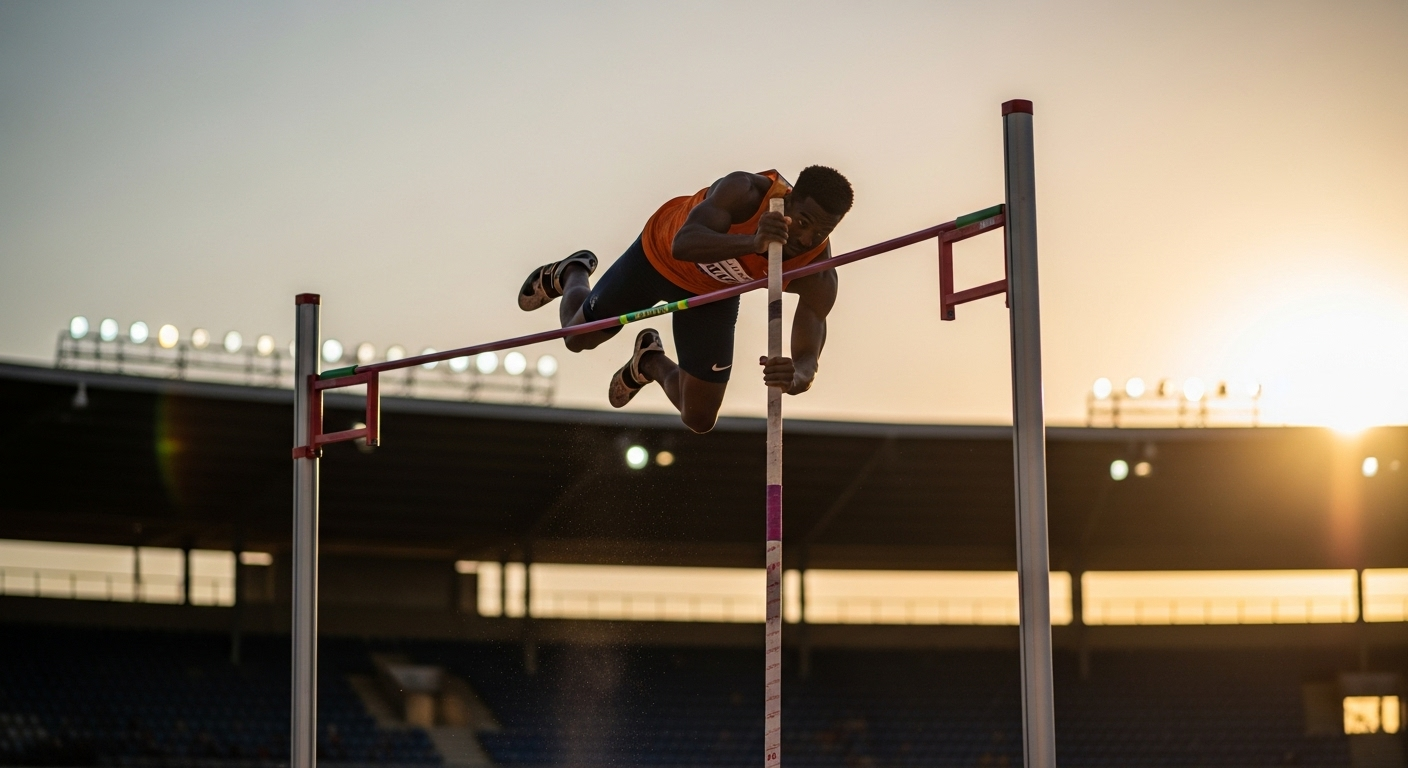The Biomechanics of Pole Vaulting: Pushing Human Limits
In the realm of track and field, pole vaulting stands as a testament to human ingenuity and physical prowess. This unique event combines speed, strength, and technical skill in a breathtaking display of aerial acrobatics. As athletes soar over bars set at dizzying heights, spectators are left in awe of the seemingly impossible feats unfolding before their eyes. But what lies beneath the surface of this captivating sport? Let's delve into the intricate world of pole vaulting biomechanics and uncover the science behind the vault.

The modern era of pole vaulting began in the 19th century, with the first recorded competition taking place in 1850 at the Ulverston Football and Cricket Club in England. Initially, vaulters used rigid poles made of wood, bamboo, or metal. The technique was rudimentary, with athletes relying primarily on their upper body strength to propel themselves over the bar.
A significant shift occurred in the 1950s with the introduction of flexible fiberglass poles. This innovation revolutionized the sport, allowing vaulters to store and release energy more efficiently. The flexible poles enabled athletes to achieve greater heights and sparked a rapid evolution in technique.
Today’s pole vaulting technique is a complex interplay of physics and biomechanics. Athletes must master a precise sequence of movements, from the approach run to the plant, take-off, swing-up, extension, and bar clearance. Each phase requires specific biomechanical considerations to maximize performance and minimize the risk of injury.
The Approach: Building Kinetic Energy
The approach run is the foundation of a successful vault. During this phase, the vaulter aims to build up maximum controllable speed. The ideal approach speed varies among athletes but typically ranges from 8 to 10 meters per second for elite male vaulters and 7 to 9 meters per second for elite female vaulters.
Biomechanically, the approach is about converting horizontal velocity into potential energy. As the vaulter accelerates, they increase their kinetic energy, which will later be transformed into potential energy as they ascend. The challenge lies in maintaining consistency in stride length and frequency while carrying the pole.
Research has shown that the last few strides of the approach are critical. Vaulters often make subtle adjustments to their stride pattern to ensure precise pole placement. This fine-tuning requires exceptional proprioception and neuromuscular control.
The Plant and Take-off: A Moment of Truth
The plant and take-off phase is perhaps the most crucial moment in pole vaulting. It’s here that the vaulter must transfer their horizontal momentum into vertical lift while initiating the bending of the pole.
During the plant, the vaulter lowers the pole tip into the box while simultaneously driving their take-off foot into the ground. This action creates a counterforce that begins to bend the pole. The timing and positioning of the plant are critical; even a slight misalignment can result in a failed vault or potential injury.
Biomechanically, the take-off is a complex interaction of forces. The vaulter must generate sufficient vertical force to initiate the pole bend while maintaining forward momentum. Studies have shown that elite vaulters can produce vertical forces of up to 5 times their body weight during take-off.
The angle of the pole at take-off is another crucial factor. Research indicates that an optimal take-off angle ranges between 15 and 20 degrees from vertical. This angle allows for efficient energy transfer from the vaulter to the pole while setting up the subsequent phases of the vault.
Pole Bending: Harnessing Elastic Energy
As the vaulter leaves the ground, the pole begins to bend, storing elastic potential energy. This bending action is a key differentiator between modern pole vaulting and its historical predecessors.
The mechanics of pole bending involve a complex interplay of materials science and physics. Modern poles are typically made from carbon fiber or fiberglass composites, carefully engineered to provide the optimal balance of strength, flexibility, and weight.
During the bending phase, the pole can store up to 2000 joules of energy. This energy storage is not uniform throughout the pole; rather, it follows a specific distribution pattern that changes as the vault progresses. Understanding this energy distribution is crucial for both pole manufacturers and vaulters, as it influences pole selection and technique.
The vaulter’s body position during this phase is critical. They must maintain a straight body alignment while swinging up and back, effectively creating a pendulum motion. This positioning helps to maximize the energy transfer from the pole to the vaulter’s body as the pole begins to straighten.
The Swing and Extension: Timing is Everything
As the pole reaches its maximum bend, the vaulter enters the swing and extension phase. This is where the stored elastic energy in the pole is converted back into kinetic energy, propelling the vaulter upwards.
The swing-up involves a rapid hip flexion movement, bringing the legs from a trailing position to a position above the vaulter’s head. This action serves two purposes: it helps to further bend the pole, increasing energy storage, and it positions the body for the subsequent extension.
Timing is crucial during this phase. Research has shown that elite vaulters initiate their swing-up when their body is at an angle of about 30 degrees past vertical. This timing allows for optimal energy transfer from the pole to the vaulter.
The extension phase begins as the pole starts to recoil. The vaulter must time their body extension to coincide with the pole’s unbending. This synchronization is vital for maximizing height. Studies using high-speed video analysis have revealed that top vaulters achieve full extension just as the pole reaches vertical.
During extension, vaulters can experience accelerations of up to 7g, highlighting the extreme forces at play in this sport. The ability to maintain body control under these conditions is a testament to the strength and skill of elite pole vaulters.
Bar Clearance: The Final Act
The bar clearance phase is the culmination of all the preceding biomechanical actions. As the vaulter reaches their peak height, they must execute a series of rotations to clear the bar efficiently.
The first rotation occurs around the longitudinal axis, allowing the vaulter to face the bar. This is followed by a rotation around the transverse axis, which helps the vaulter’s hips clear the bar. Finally, a second longitudinal rotation may be employed to ensure the legs clear the bar.
These rotations are not merely for show; they serve a crucial biomechanical purpose. By manipulating their body position, vaulters can adjust their center of mass relative to the bar, allowing them to clear heights that exceed their peak center of mass height.
Research has shown that elite vaulters can clear bars that are up to 20 centimeters higher than their maximum center of mass height. This remarkable feat is achieved through precise body control and an understanding of rotational mechanics.
The Role of Equipment in Biomechanics
While the vaulter’s technique is paramount, the equipment used in pole vaulting plays a significant role in the sport’s biomechanics. The pole, in particular, is a critical piece of equipment that directly influences performance.
Modern poles are highly specialized, with varying degrees of stiffness and flex points. Vaulters must select poles based on their weight, approach speed, and technical proficiency. The interaction between the vaulter and the pole is a delicate balance; a pole that is too stiff may not bend sufficiently, while one that is too flexible may not provide enough recoil energy.
The composition of the landing area also affects biomechanics, particularly in terms of injury prevention. Modern landing pits are designed to absorb impact forces gradually, reducing the risk of injury during unexpected landings.
Footwear is another important consideration. Pole vaulting shoes are designed with a rigid sole to facilitate energy transfer during the plant and take-off phases. Some designs even incorporate spikes on the heel to provide additional traction during the final steps of the approach.
Biomechanical Analysis and Training
Advancements in technology have revolutionized how pole vaulting biomechanics are studied and applied in training. High-speed video analysis, force plates, and 3D motion capture systems allow coaches and biomechanists to dissect every aspect of a vault in minute detail.
These tools enable the identification of subtle technique flaws that may not be visible to the naked eye. For example, force plate data can reveal imbalances in take-off force production, while motion capture can highlight inefficiencies in the swing-up phase.
Biomechanical analysis has led to the development of specialized training exercises that target specific aspects of the vault. For instance, pole runs without vaulting help athletes perfect their approach, while rope climbs simulate the muscle activation patterns required during the swing-up.
Understanding the biomechanics of pole vaulting has also influenced strength and conditioning programs. Vaulters now engage in exercises that mimic the specific force production patterns encountered during a vault, such as plyometric drills and Olympic lifts.
Injury Prevention Through Biomechanics
The extreme forces involved in pole vaulting make injury prevention a critical concern. Biomechanical research has played a crucial role in identifying risk factors and developing strategies to mitigate them.
One area of focus has been the loading patterns on the upper extremities during the plant and swing phases. Studies have shown that vaulters can experience forces of up to 7 times their body weight through their shoulders and arms. This knowledge has led to the development of specific strengthening exercises for the upper body and techniques to distribute these forces more evenly.
The take-off phase has also been scrutinized from an injury prevention perspective. Improper take-off mechanics can lead to excessive stress on the lower back and knees. Biomechanical analysis has helped in refining take-off techniques to minimize these risks.
Landing mechanics have been another area of research. While modern landing pits have greatly reduced the risk of serious injury, improper landing technique can still result in sprains and strains. Biomechanical studies have informed the development of safe landing strategies, emphasizing the importance of body position and impact distribution.
The Future of Pole Vaulting Biomechanics
As our understanding of human biomechanics and materials science continues to advance, the future of pole vaulting looks exciting. Researchers are exploring new pole materials that could provide even greater energy storage and release properties.
Wearable technology is also poised to revolutionize pole vaulting training and performance analysis. Inertial measurement units (IMUs) and smart textiles could provide real-time feedback on body position and movement patterns during vaults.
Virtual reality (VR) and augmented reality (AR) technologies are being explored as training tools. These technologies could allow vaulters to practice their technique in a safe, controlled environment while receiving immediate biomechanical feedback.
Genetic research and personalized training programs based on individual biomechanical profiles may become more prevalent, allowing coaches to tailor training regimens to each athlete’s unique physical characteristics and movement patterns.
The Intersection of Art and Science
While the biomechanics of pole vaulting are rooted in hard science, the execution of a perfect vault remains an art form. The fluidity and grace exhibited by elite vaulters belie the complex physical principles at work.
As we continue to push the boundaries of human performance, pole vaulting serves as a beautiful example of the symbiosis between athletic prowess and scientific understanding. Each record-breaking vault is not just a testament to the athlete’s skill and dedication but also to our ever-expanding knowledge of human biomechanics.
The sport of pole vaulting continues to captivate audiences and inspire athletes to reach new heights, both literally and figuratively. As we look to the future, it’s clear that the intersection of biomechanics, technology, and human determination will propel this spectacular event to even greater heights.
In conclusion, the biomechanics of pole vaulting offer a fascinating glimpse into the complexities of human movement and the application of physics in sport. From the initial approach to the final bar clearance, every phase of the vault is a carefully orchestrated sequence of biomechanical events. As our understanding of these principles deepens, we can expect to see continued advancements in technique, training methods, and equipment design. The pole vault stands as a shining example of how scientific knowledge can elevate athletic performance, pushing the boundaries of what we once thought possible.




